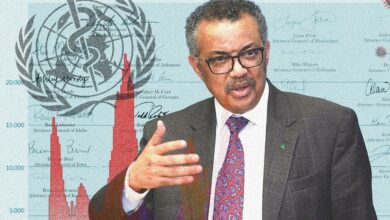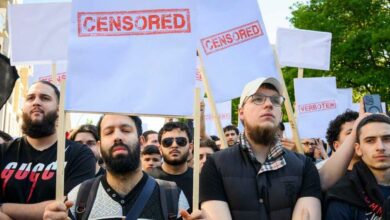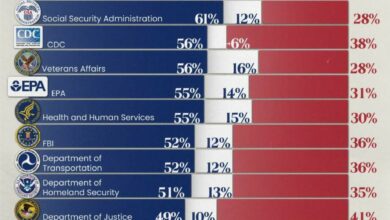‘A Step Back In Time’: America’s Catholic Church Sees An Immense Shift Toward The Old Ways

It was the music that changed first. Or maybe that’s just when many people at the pale brick Catholic church in the quiet Wisconsin neighborhood finally began to realize what was happening.
The choir director, a fixture at St. Maria Goretti for nearly 40 years, was suddenly gone. Contemporary hymns were replaced by music rooted in medieval Europe.
So much was changing. Sermons were focusing more on sin and confession. Priests were rarely seen without cassocks. Altar girls, for a time, were banned.
At the parish elementary school, students began hearing about abortion and hell.
“It was like a step back in time,” said one former parishioner, still so dazed by the tumultuous changes that began in 2021 with a new pastor that he only spoke on condition of anonymity.
It’s not just St. Maria Goretti.
Across the U.S., the Catholic Church is undergoing an immense shift. Generations of Catholics who embraced the modernizing tide sparked in the 1960s by Vatican II are increasingly giving way to religious conservatives who believe the church has been twisted by change, with the promise of eternal salvation replaced by guitar Masses, parish food pantries and casual indifference to church doctrine.
The shift, molded by plummeting church attendance, increasingly traditional priests and growing numbers of young Catholics searching for more orthodoxy, has reshaped parishes across the country, leaving them sometimes at odds with Pope Francis and much of the Catholic world.
The changes are not happening everywhere. There are still plenty of liberal parishes, plenty that see themselves as middle-of-the-road. Despite their growing influence, conservative Catholics remain a minority.
Yet the changes they have brought are impossible to miss.
The progressive priests who dominated the U.S. church in the years after Vatican II are now in their 70s and 80s. Many are retired. Some are dead. Younger priests, surveys show, are far more conservative.
“They say they’re trying to restore what us old guys ruined,” said the Rev. John Forliti, 87, a retired Twin Cities priest who fought for civil rights and reforms in Catholic school sex education.
Doug Koesel, an outspoken 72-year-old priest at Blessed Trinity Parish in Cleveland, was blunter: “They’re just waiting for us to die.”
At St. Maria Goretti, once steeped in the ethos of Vatican II, many parishioners saw the changes as a requiem.
“I don’t want my daughter to be Catholic,” said Christine Hammond, whose family left the parish when the new outlook spilled into the church’s school and her daughter’s classroom. “Not if this is the Roman Catholic Church that is coming.”
But this is not a simple story. Because there are many who welcome this new, old church.
They often stand out in the pews, with the men in ties and the women sometimes with the lace head coverings that all but disappeared from American churches more than 50 years ago. Often, at least a couple families will arrive with four, five or even more children, signaling their adherence to the church’s ban on contraception, which most American Catholics have long casually ignored.
They attend confession regularly and adhere strictly to church teachings. Many yearn for Masses that echo with medieval traditions – more Latin, more incense more Gregorian chants.
“We want this ethereal experience that is different from everything else in our lives,” said Ben Rouleau, who until recently led St. Maria Goretti’s young adult group, which saw membership skyrocket even as the parish shrank amid the turmoil.
They are, Rouleau said, happily out of touch with a liberal city like Madison.
“It’s radical in some ways,” Rouleau said. “We’re returning to the roots of the church.”
If this movement emerged from anywhere, it might be a now-demolished Denver football stadium and a borrowed military helicopter carrying in Pope John Paul II.
Some 500,000 people descended on Denver in 1993 for the Catholic festival World Youth Day. When the pope’s helicopter landed just outside Mile High Stadium, the ground shook from the stomping.
The pope, whose grandfatherly appearance belied an electric charisma, and who was beloved both for his kindness and his sternness, confronted an American church shaped by three decades of progressive change.
If the church is often best known to non-Catholics for its opposition to abortion, it had grown increasingly liberal since Vatican II. Birth control was quietly accepted in many parishes, and confession barely mentioned. Catholic social teaching on poverty suffused churches. Most priests traded in their cassocks for plain black shirts with Roman collars. Incense and Latin became increasingly rare.
On some issues, John Paul II agreed with these liberal-minded Catholics. He spoke against capital punishment and pushed for workers’ rights. He preached relentlessly about forgiveness – “the oxygen that purifies the air of hatred.” He forgave his own would-be assassin.
But he was also uncompromising on dogma, warning about change and cracking down on liberal theologians. He urged a return to forgotten rituals.
Catholics “are in danger of losing their faith,” he told crowds at the final Denver Mass, decrying abortion, drug abuse, and what he called “sexual disorders,” a barely veiled reference to growing acceptance of gay rights.
Across the nation, fervent young Catholics listened.
Newman Centers, which serve Catholic university students, became increasingly popular. So did FOCUS, a traditionalist organization working on American college campuses. Conservative Catholic media grew, particularly the cable TV network EWTN, a prominent voice for increased orthodoxy.
Today, conservative Catholic America has its own constellation of online celebrities aimed at young people. There’s Sister Miriam James, an ever-smiling nun in full habit who talks openly about her hard-partying college days. There’s Jackie Francois Angel, who speaks in shockingly frank detail about sex, marriage and Catholicism. There’s Mike Schmitz, a movie-star handsome Minnesota priest who exudes kindness while insisting on doctrine.
Even today, surveys show most American Catholics are far from orthodox. Most support abortion rights. The vast majority use birth control.
But increasingly, those Catholics are not in church.
In 1970, more than half of America’s Catholics said they went to Mass at least once a week. By 2022, that had fallen to 17%, according to CARA, a research center affiliated with Georgetown University. Among millennials, the number is just 9%.
Even as the U.S. Catholic population has jumped to more than 70 million, driven in part by immigration from Latin America, ever-fewer Catholics are involved in the church’s most important rites. Infant baptisms have fallen from 1.2 million in 1965 to 440,000 in 2021, CARA says. Catholic marriages have dropped by well over two-thirds.
The shrinking numbers mean that those who remain in the church have outsized influence compared with the overall Catholic population.
On the national level, conservatives increasingly dominate the U.S. Catholic Bishops Conference and the Catholic intellectual world. They include everyone from the philanthropist founder of Domino’s Pizza to six of the nine U.S. Supreme Court justices.
Then there’s the priesthood.
Young priests driven by liberal politics and progressive theology, so common in the 1960s and 70s, have “all but vanished,” said a 2023 report from The Catholic Project at Catholic University, based on a survey of more than 3,500 priests.
Today’s young priests are far more likely to believe that the church changed too much after Vatican II, tangling itself up in America’s rapidly shifting views on everything from women’s roles to LGBTQ people.
“There really aren’t very many liberals in the seminaries anymore,” said a young, recently ordained Midwestern priest. He spoke on condition of anonymity because of the turmoil that engulfed his parish after he began pressing for more orthodox services. “They wouldn’t feel comfortable.”




